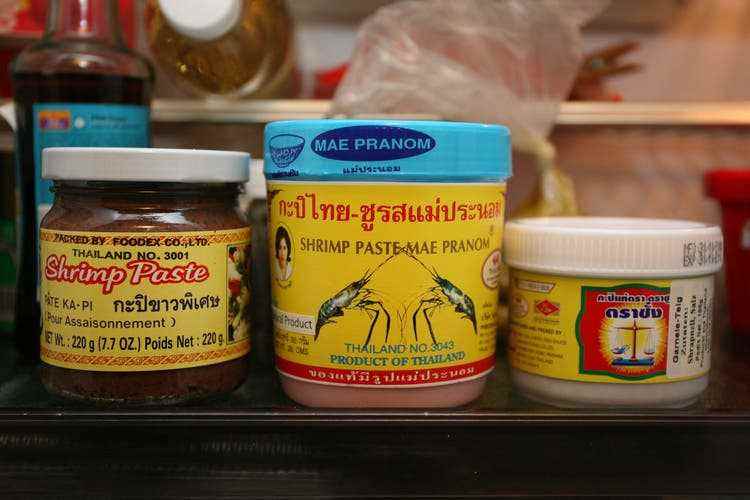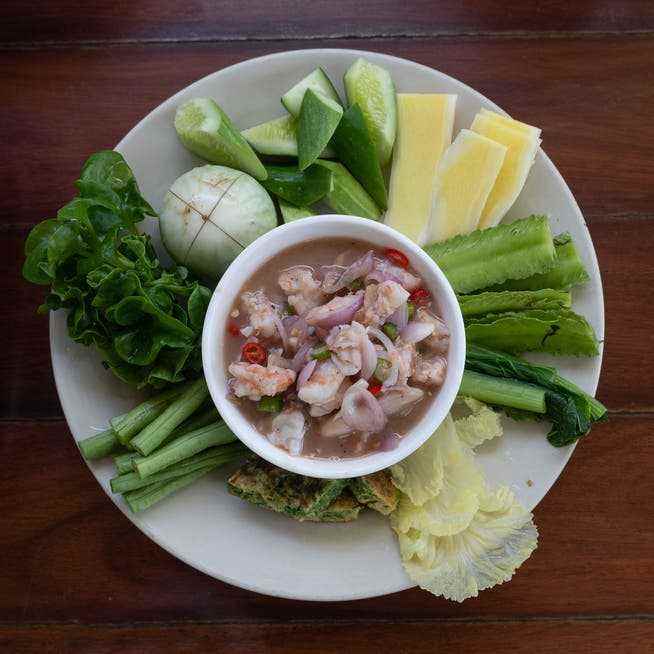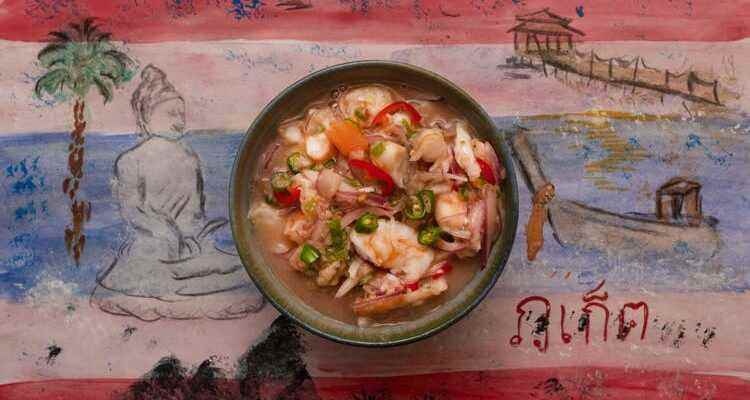Where would the Thais be without their relishes and dips? There are endless variants, all of which have their own names and are usually linked to specific regions in the country. What is special about Nam chup yum is that fresh shrimp are added to the mix.
Where would the Thais be without their relishes? Nam chup yum is just one of the many variations.
Nam chup yum: Shrimp paste, garlic, chili and tamarind relish with fresh shrimp
« Taste! This is the essence of our country! Not just any curry. . .» The man is reaching through the air with his right hand as if trying to conjure up the images of various curries. Then he pushes the paper plate with the uncooked vegetables a little closer to me. In the middle of the raw vegetables is a sky-blue plastic bowl with a reddish-grey sauce. I don’t feel the slightest desire to embark on such an experiment so early in the day.
Phuket Town’s Central Market is not an overly picturesque experience. In the gloomy hall only a few greengrocers, fishermen and butchers offer their wares, randomly thrown bunches of lettuce, fresh produce in plastic bags and metal tanks full of carcasses in the glow of flickering neon tubes and bare energy-saving light bulbs. Three quarters of the stands are empty.
I was on my way to Thalang Road in the center of Phuket Town, where I wanted to see the “magnificent houses in the Sino-Portuguese style”, the “most beautiful old town in Thailand”, as the prospectuses rave, the “jewel”, the “glittering star of the Andaman Sea». But then, instead of glitter, a heavy rain suddenly broke out of the sky, which had been gloomy for hours. Suddenly, as if by magic, all the locals wore colored capes – I, on the other hand, found that I had even left my umbrella in the hotel room. So I took refuge in the nearest building that was accessible.
Tropical rains are known to be heavy, but short-lived. But this one may not play by the rules. Every time I want to continue my way, it sends a new volley of drops to the ground. So I circle around the few stalls again and again – until the saleswomen start giggling at me.

Central Market of Phuket Town: No tourists, no business.
“Why is this market so empty?” I ask my new acquaintance, who is wearing a canary-yellow plastic wrap and a half-open motorcycle helmet with Snoopy sticker on his head.
«Oh, that’s because of Corona, otherwise everything is full here. But now: no tourists, no business, no market.”
‘Isn’t this a market for the people here? For the locals?”
“Local people?” He laughs, revealing a row of dark stumps of teeth: ‘Yes, yes, this is a local market. But a lot of restaurants shop here, a lot of small inns – usually, but now . . .»
I adjust my backpack, step back a little and say a firm «So, I have to . . .» into the air, followed by a slight bow. But he gently places his small, gnarled hand on my forearm: “You know papaya salad, tom kha gai, phat thai?” I nod and feel my forehead wrinkle impatiently. “Try this and you’ll really understand how we eat here in Thailand.”
I look at the greyish sauce again and still don’t want to get over myself: “I can’t eat anything now. blood sugar levels! Problem! You understand. But what is that?”
“Nam chup yum.”
“Well what?”
“Wait!” He rushes to a fish stall, comes back with a note and a pen, scratches a few letters on the damp paper, and hands it to me. I say goodbye quickly and carry the scrap with two fingers out to the market on the street. It has finally stopped raining.
For someone who likes to mimic the culinary adventurer, that wasn’t exactly a heroic feat. And the encounter, the man’s words won’t let go of me all day long. When I join the small group of journalists with whom I traveled to the island of Phuket in the evening, I immediately ask our companion Noi if she knows Nam chup yum. Her eyes light up and make me realize that I really missed something at the Central Market. She explains exactly how her family makes this relish, then makes sure I have a small bowl on my table next time we go to a restaurant. Nam chup yum turns out to be a Phuket island version of nam phrik, a category of relishes, sauces, pastes or dips not often found in restaurants, but actually something like that like the “soft core of Thai cuisine” as chef David Thompson describes it. King Chulalongkorn, the country’s great modernizer, is said to have repeatedly lamented how much he missed Nam phrik during his travels through Europe. And the cookbook author Leela Punyaratabandhu gets excited: “What would the Thais be without their relishes? Without Nam phrik her life would certainly be possible, but meaningless.»

Shrimp paste is one of the most important basic ingredients in Thai cuisine and can be found in every Asian shop.
Thais have been making these dips for hundreds of years from simple, usually very spicy and hot ingredients, which they pound together in a mortar and traditionally eat with lots of rice, which softens the heat and quenches hunger. There are endless variants, all of which have their own names and are usually linked to specific regions in the country. Today Nam phrik is also often served with raw or steamed vegetables. The most popular of these relishes is nam phrik gapi, which consists of shrimp paste, garlic, salt, chilies, sugar, lime juice, and sometimes some fish sauce, roasted shallots, and coriander root. Shrimp paste (gapi) is one of the most important basic ingredients in Thai cuisine and can be found in every Asian shop. It is made from small shrimp that are salted, fermented, dried and finally mashed. Gapi has an unusually strong, spicy odor that provokes savage grimaces in most. The art of a successful nam phrik is to play around this aroma with other ingredients in such a way that it can be perceived as tasty – without watering down the taste of the paste.
Nam chup yum is prepared on a very similar principle, adding fresh shrimp to the mix and sometimes substituting tamarind for lime (albeit giving it a dark brownish, unappetizing hue). You should also let your intuition and your own sense of taste guide you when preparing this sauce – not least because the shrimp pastes differ in strength and aroma depending on the brand. You may be able to add a little more (roasted) onion to the sauce, add more sugar or acid and, according to Noi in Phuket, dilute it with a bit of water or broth.
In Phuket, nam chup yum is served with nothing but uncooked vegetables, such as snake beans, a golf ball-sized eggplant, cucumber, white turmeric, runner beans and tender cabbage leaves. Here in Central Europe, I combine the relish with raw or steamed seasonal vegetables from the region – and whenever I enjoy this hot, sour, salty and very slightly sweet dip with a mixture of amazement and enthusiasm, I promise myself that I will never eat again turn down a culinary gift just because it looks a bit greyish and is being pushed towards me by a man with black teeth.

In this country, Nam chup yum can be combined with raw or steamed seasonal vegetables from the region.
Ingredients (for 2 people)
- 3 cloves of garlic
- 2 green Thai chilies, in rings, for crushing
- ⅓ tsp salt
- 7 g shrimp paste (gapi), equivalent to 1 teaspoon heaped
- ½ tsp sugar
- ½ tsp lime zest
- 2 tbsp lime juice
- 1 tsp fish sauce
- 30 g red shallots, cut into very fine strips
- 2 green Thai chilies in wheels
- 2 red Thai chillies in wheels
- 50 g cooked shrimp tails
- 1-2 tbsp water, optional
Preparation (15 minutes)
- Crush the garlic, 2 green chillies and salt in a mortar and pestle to form a fine paste. The finer you mash the chillies, the hotter the sauce will be. If you like it less spicy, you can remove the seeds from the chillies before using the mortar.
- Add the shrimp paste and mix well with a mortar and pestle. You can also wrap the paste in aluminum foil before using the mortar and heat it in the oven for a few minutes, but you must not let it burn.
- Stir in the sugar, lime zest, lime juice and fish sauce.
- Add the shallots, green and red chillies in wheels. You can roast the peeled shallots briefly over the gas flame before use, which gives the relish an additional aroma. If you remove the seeds from the chillies, the sauce will be less spicy.
- Halve the shrimp crosswise, cut lengthwise into flat slices, add to the relish. If necessary, dilute everything a little with 1-2 tablespoons of water and stir well.
